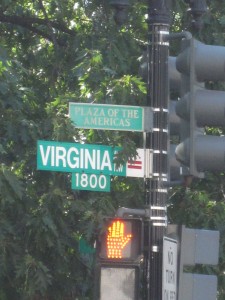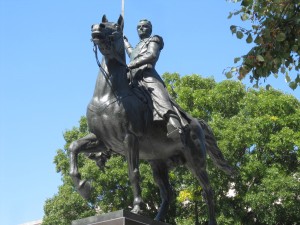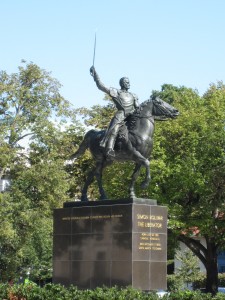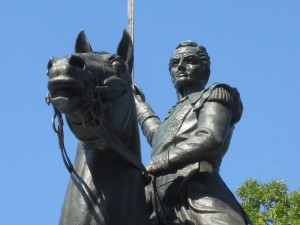(The previous portion of this series: The House of the Americas)
Listen: I’m not your mother. Really, I’m not. I think you know that already. And honestly, I don’t want to be. Not in the least. I only say this because I’ve got the nagging feeling, a sneaking suspicion as my father used to say, that I might be putting you in harm’s way by suggesting you take this walk down Virginia Avenue. So let me go ahead and say the eight little words I can no longer, even though I’m not your mom, resist saying:
LOOK BOTH WAYS BEFORE YOU CROSS THE STREET!
I feel better. I mention this for two reasons. One, if you are carrying a printed version of this guide while walking, I worry it might be too easy to become absorbed in the words (my brilliant, riveting prose) or the features they are describing, and not focus on traffic. But also, a pedestrian strolling along Virginia, a street set on a diagonal line relative to most of the other streets, needs to keep an eye out for the unusual intersections with odd crossings. These sometimes five and six way intersections add to the street’s charm, but can make it a challenge to get where you want to go. I’ll note those crossings as we progress down the Avenue. For now, Stop Reading This for a minute, and carefully cross 18th street where you begin the 1800 block of Virginia.
Another Liberator greets you the moment you cross the street. Simon Bolivar is there astride a horse, focusing intently on where he’s going, stirruped feet splayed in either direction, sword raised, announcing to any and all that the colonized will be freed, the bound, liberated. The statue almost goes too far praising Bolivar. Everything about it is outsized: the horse, the rider, the sword. Even (I’m not an expert on equestrian statues but this seems the case to me) the horse’s genitalia (it’s a stallion to be sure; do great generals ever ride mares?) look huge to me.
I think it’s funny that the horse is looking in the same direction as Bolivar, adding to the statue’s sense of purpose and focused, strong direction. Just in case you haven’t yet picked up on what a great man Bolivar was, take a peek at the phrase engraved on the pedestal’s west face: “Liberated Venezuela, Columbia, Ecuador, Peru, Bolivia, and Panama.” And that was just before lunch. No seriously, he was a great man who did great things and in fact is sometimes called the George Washington of South America.
Bolivar was born in September 1783, two months before the Treaty of Paris officially ended the American Revolutionary War. He was born into a wealthy family and received a complete and enlightened education from a number of tutors and scholars who exposed him to writers like Rousseau and Voltaire whose writings also influenced the North American founding fathers. He married at 19 but his wife died of yellow fever a year later and he never remarried. To drown his sorrows he traveled to Europe returning several times before he started his career as a Liberator. There, he visited the great capitals, London, Madrid, Rome, and Paris where he witnessed Napoleon’s coronation. While in Europe, he became convinced that the people of South America needed to be freed from the yoke of colonialism. With military training but no experience, he became the leader of the revolutionary armies. If you want to read about the many and complex battles he fought and the ebb and flow of war leading to Spain’s defeat, go check out a book about it from the library, or search online. It’s enough for now to say he led the people to victory and became the leader of a country called Gran Columbia, a huge nation that included parts of six current South American nations.
I find it ironic that the word Columbia, derived from the early European explorer Christopher Columbus’s name, was and still is used so widely in the New World (many people wanted to name our country Columbia instead of The United States of America) to name nations that freed themselves from the yoke of colonialism of which Columbus was a precursor. I’m not criticizing Columbus, I’m just commenting on how a name or a word can become such a part of the fabric of human culture.
And speaking of names (like Washington) that became widely used, many things from cities to universities and more are named after Bolivar. For example, the country of Bolivia is named after him. So is the currency of Venezuela, his country of birth and the nation that gave the statue to the United States in 1958. You can see this theme in this poem by the Pulitzer winning Chilean poet, Pablo Neruda.
Chant to Bolivar
Our Father thou art in Heaven,
in water, in air
in all our silent and broad latitude
everything bears your name, Father in our dwelling:
your name raises sweetness in sugar cane
Bolivar tin has a Bolivar gleam
the Bolivar bird flies over the Bolivar volcano
the potato, the saltpeter, the special shadows,
the brooks, the phosphorous stone veins
everything comes from your extinguished life
your legacy was rivers, plains, bell towers
your legacy is our daily bread, oh Father.
(Pablo Neruda)
(More Bolivar Photos – start on page four of the gallery)
(The next portion of the walk: Like a Latin Villa)




